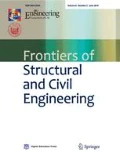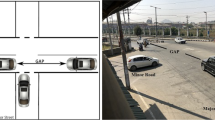Abstract
Roundabouts are becoming a preferred form of intersection control type due to their safety and capacity benefits. Yield control at roundabout entries inherently reduces fuel consumption and emissions when compared to other conventional intersection types. However, these benefits can be limited by poor driver behavior and judgment when entering the roundabout. This research addresses the nature of gap distributions and use of turn indicators by exiting vehicles at three single-lane roundabouts in Vermont, New York, and Alaska. Presented here is a comparison of vehicle headways measured at two different locations in each roundabout. Rejected headways are analyzed in the context of priority abstaining events when entering drivers yield to vehicles exiting on the same leg of the roundabout suggesting that “true” critical gaps are being overestimated. Results indicate that exiting vehicles, particularly those that do not use their turn indicators when departing from the major-stream of traffic have an influence on the entry decision of drivers on the same approach. This behavior is of particular concern for intersection efficiency (i.e., delay) and sustainability (i.e., excess fuel consumption and emissions). Results prompt the consideration of more consistent guidance on and enforcement of turn indicator use during roundabout negotiations.
Similar content being viewed by others
References
Transportation Research Board. Highway Capacity Manual 2010. Washington, D C: National Academy of Science, 2010
Belz N P, Aultman-Hall L, Garder PE, Lee BHY. An event-based framework for non-compliant driver behavior at single-lane roundabouts. Transportation Research Record No. 2402, Journal of the Transportation Research Board of the National Academies. 2014, C: 38–46
Akcelik R. The relationship between capacity and driver behaviour. In: Proceedings of the 2nd International Conference on Roundabouts. Kansas City, MO: Transportation Research Board of the National Academies, 2008, 1–14
Gårder P E. Little Falls, Gorham: Reconstruction to a Modern Roundabout. Transportation Research Record: Journal of the Transportation Research Board No. 1658, Transportation Research Board of the National Academies, Washington, D C, 1999, 17–24
Kimber R. Traffic Capacity of Roundabouts, Laboratory Report 942. Crawthorne, Berkshire, England: Transport and Road Research Laboratory, 1980
Troutbeck R, Kako S. Limited Priority Merge at Unsignalized Intersections. Transportation Research Part A, Policy and Practice, 1999, 33(3–4): 291–204
Kimber, R., and Semmens, M. A Track Experiment on the Entry Capacities of Offside Priority Roundabouts. Crowthorne, England: Supplementary Report 334, Transport and Road Research Laboratory, 1977
Brilon W, Stuwe B. Roundabouts in Germany: Recent Results Regarding Capacity and Safety. Nantes, France: In Actes du Seminar “Giratoir 92”, 1993
Louah G. Recent French Studies on Capacity and Waiting Times at Rurual Unsignalized Intersections. Proceedings of Intersections Without Traffic Signals II, International Workshop. Bochum, Germany, 1988
Simon M. Roundabouts in Switzerland: Recent Experiences, Capacity, Swiss Roundabout Guide. In: Proceedings of Intersections Without Traffic Signals II, International Workshop. Bochum, Germany, 1991
Hagring O. Derivation of Capacity Equation for Roundabout Entry with Mixed Circulating and Exiting Flows. Transportation Research Record: Journal of the Transportation Research Board No. 1776, Transportation Research Board of the National Academies, Washington, D C, 2001, 91–99
Mereszczak Y, Dixon M, Kyte M, Rodegerdts L, Blogg M. Including Exiting Vehicles in Capacity Estimation at Single-Lane US Roundabouts. Transportation Research Record: Journal of the Transportation Research Board No. 1988, Transportation Research Board of the National Academies, Washington, D C, 2006, 23–30
Brilon W. Intersections without Traffic Signals, Vol. II. Berlin: Springer-Verlag, 1991
Federal Highway Administration. Roundabouts: An Informational Guide. Mclean, VA: Turner-Fairbank Highway Research Center, 2000
Rodegerdts, et al. NCHRP Report 672: Roundabouts: An Informational Guide. Transportation Research Board of the National Academies, Washington, D C, 2010
Curtis D. Noble v. State of Alaska. Court of Appeals of the State of Alaska, No. A-11041, Trial Court No. 4FA-10–4690 CR, No. 2473–September 4, 2015
National Committee on Uniform Traffic Laws and Ordinances. Uniform Vehicle Code. Alexandria, VA, 2000
Wei T, Grenard J L. Calibration and Validation of Highway Capacity Manual 2010 Capacity Model for Single-Lane Roundabouts. Transportation Research Record: Journal of the Transportation Research Board, No. 2286, Transportation Research Board of the National Academies, Washington, D C, 2012, 105–110
Ashworth R. The capacity of priority-type intersections with a nonuniform distribution of critical acceptance gaps. Transportation Research, 1969, 3(2): 273–278
Brilon W, Koenig R, Troutbeck R J. Useful estimation procedures for critical gaps. Transportation Research Part A, Policy and Practice, 1999, 33(3-4): 161–186
Drew D R. Traffic Flow Theory and Control. New York: McGraw-Hill, 1968
Raff M. A Volume Warrant for Urban Stop Signs. Saugatuck, CT: The Eno Foundation for Highway Traffic Control, 1950
Hagring O. Estimation of critical gaps in two major streams. Transportation Research Part B: Methodological, 2000, 34(4): 293–313
Tian Z, Vandehey M, Robinson B W, Kittelson W, Kyte M, Troutbeck R, Brilon W, Wu N. Implementing the maximum likelihood methodology to measure a driver’s critical gap. Transportation Research Part A, Policy and Practice, 1999, 33(3–4): 187–197
Tian A.A Further investigation on critical gap and follow-up time. In: Proceedings of the 4th International Symposium on Highway Capacity. Transportation Research Board of the National Academies, Washington, D C, 2000, 397–408
Kittelson W K, Vandehey M A. Delay effects on driver gap acceptance characteristics at two-way stop-controlled intersections. Transportation Research Record, vol. 1320. Transportation Research Board, Washington, D C, 1991, 154–159
Polus A, Shmueli S. Entry capacity at roundabouts and impact of waiting times. Road and Transport Research, 1999, 8: 43–54
Xu F, Tian Z Z. Driver Behavior and Gap-Acceptance Characteristics at Roundabouts in California, Transportation Research Record. Journal of the Transportation Research Board, No. 2071, Transportation Research Board of the National Academies, Washington, D C, 2008, 117–124
Author information
Authors and Affiliations
Corresponding author
Rights and permissions
About this article
Cite this article
Belz, N.P. Investigating the role of exiting vehicles and turn indicator usage in gap acceptance at single-lane roundabouts. Front. Struct. Civ. Eng. 11, 8–16 (2017). https://doi.org/10.1007/s11709-016-0365-7
Received:
Accepted:
Published:
Issue Date:
DOI: https://doi.org/10.1007/s11709-016-0365-7




